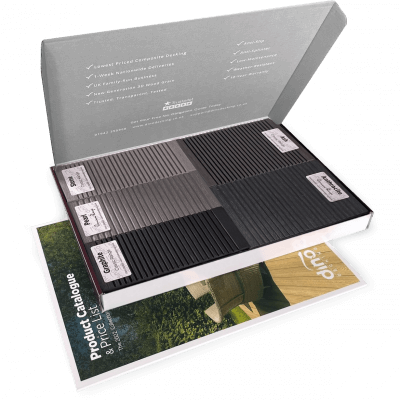5 Composite Decking Lighting Ideas
Our composite decking looks great in any setting, but you can really make your outdoor spaces shine with our decking
Products in Stock
Lowest Prices
Express Delivery
10-Year Warranty
Bank Holiday Weekend Sale. Up To 15% Off.

Embarking on a composite decking project? You’re in for a treat. These modern materials offer durability and low maintenance, but they do require some special handling when it comes to cutting. Don’t fret, though – with the right tools and techniques, you’ll be slicing through composite boards like a pro in no time. Let’s delve into the nitty-gritty of how to cut composite decking effectively and safely in your UK garden.
Before you start making sawdust, it’s vital to have the right tools at your disposal. Here’s what you’ll need:
A circular saw, mitre saw, and jigsaw should cover most of your cutting needs. Each has its strengths, which we’ll explore shortly.
Opt for fine-toothed blades designed for cutting composite materials. They’ll give you cleaner cuts and last longer.
A tape measure, set square, and pencil are indispensable for accurate cuts.
Never underestimate the importance of safety goggles, ear defenders, and a dust mask.
Proper preparation can make the difference between a smooth operation and a frustrating experience. Let’s get everything in order.
This age-old carpentry adage holds true for composite decking. Double-check your measurements and mark your cutting lines clearly.
Set up a sturdy workbench or saw horses to support your boards. A stable surface is essential for safe, accurate cuts.
Now, let’s get into the specifics of cutting composite decking with different tools.
The circular saw is your go-to for long, straight cuts. Here’s how to use it effectively:
Set your blade depth to just barely clear the thickness of the board. This minimises splintering and makes for a cleaner cut.
For perfectly straight cuts, clamp a straight edge to your board as a guide for your saw. This technique can save you from wobbly lines and potential mistakes.
When it comes to angled cuts and cross cuts, the mitre saw is your best bet. Here’s how to make the most of it:
For angled cuts, set your mitre saw to the desired angle and make a test cut on a scrap piece first. This ensures accuracy before you cut your good boards.
For straight cross cuts, ensure your board is snug against the fence before making your cut. This guarantees a square edge every time.
Need to cut curves or make intricate cutouts? The jigsaw is your tool of choice. Here’s how to use it effectively:
Mark your curve clearly and take it slow. Let the saw do the work – don’t force it.
To prevent splintering on the top surface, cut with the good side down when using a jigsaw.

You’ve made your cuts, but you’re not quite done yet. These final steps ensure a professional finish.
Composite decking can leave rough edges after cutting. A quick once-over with fine-grit sandpaper can smooth things out nicely.
Ensure all your cut edges are clean and smooth before installation. This not only looks better but can also prevent future issues.
Clear away all debris and dust from your work area and the cut boards. A clean board installs more easily and looks better from the start.
Take a moment to inspect all your cuts. Any issues are much easier to address now than after installation.
Even with the best preparation, you might encounter some challenges. Here’s how to handle them:
To minimise warping and splintering, always support the board close to the cut line and use sharp, appropriate blades.
Remember that composite decking expands and contracts with temperature changes. Leave appropriate gaps during installation to accommodate this movement, especially important in the UK’s variable climate.
Armed with these tips and techniques, you’re well-prepared to tackle your composite decking project. Remember, practice makes perfect, so don’t be afraid to make some test cuts on scrap pieces before diving into your good boards.
For more in-depth information on working with composite decking, including installation and maintenance tips suited to the UK climate, check out our comprehensive deck repair guide. It’s packed with valuable insights to help you get the most out of your decking project.And if you’re still in the planning stages and haven’t yet chosen your decking materials, why not explore our range of top-quality composite decking options? You can easily order quality composite decking in the UK from our extensive selection, so you can be sure that you have the best materials for your project.

Our sample pack contains a sample piece of each colour currently available. Order your free sample pack today to compare the colours and get a true feeling of the Dino Decking range!
Our composite decking looks great in any setting, but you can really make your outdoor spaces shine with our decking
If the idea of having rats under your decking makes you shiver, don’t worry. We’ll let you know the signs
Business hours
Monday: 09:00 – 17:30
Tuesday: 09:00 – 17:30
Wednesday: 09:00 – 17:30
Thursday: 09:00 – 17:30
Friday: 09:00 – 17:30
Saturday: Closed
Sunday: Closed
Contact us
01942 355968
support@dino.co.uk
Collection Address: Unit 1 Wetheral Close Hindley Ind Estate Wigan Greater Manchester North West WN2 4HS
Pages
Products
Testing
Copyright 2025 Dino Decking Ltd All Rights Reserved.
VAT Number: GB296097848.
Company Number: 10837233.